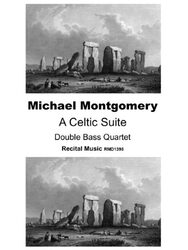Your basket is currently empty!
Hirta
A Sketch of Daily Life on St Kilda

Description
HIRTA is a fun, lively and evocative one-movement work, aimed at the intermediate bass quartet and offering something of interest for each player. Scottish influences …abound in a work of character and contrasts, detailing the daily life of the St. Kildan population in the late 19th-century. A musical soundscape of the island is clearly portrayed, from sunrise to sunset, including a wonderfully lively and toe-tapping ‘ceilidh’ with its rhythmic and syncopated bass line. HIRTA – a Sketch of Daily Life on St. Kilda was composed for the 2008 BIBF Composition Competition and was premiered at Wells Cathedral School (Somerset) in April 2009 during Bass-Fest @ Wells. ‘Hirta – a Sketch of Daily Life on St. Kilda for Double Bass, Quartet was composed in 2008. As the title suggests, it depicts the lives of the people who once lived on this isolated archipelago off of the coast of Scotland of which Hirta is the largest island. Ms. Gordon, who studied at the Royal Academy of Music and the Royal Northern College of Music in the UK, uses her composition to paint a picture of everything that might have taken place on the island from sunrise to sunset. For instance, the hard manual labor of peat cutting, which is described as “a vital team activity to gather fuel for their fires,” is depicted by two players playing alternately accented on and off beats while the other two players play a four-bar phrase with a recurring dotted rhythmic figure. On the other hand, a traditional gathering and dance called a “ceilidh” is written as a dance in 6/8. The composition is modal and employs unison playing, and repetitive lyrical and rhythmic material, used to reflect the simple lives of the inhabitants of the island. This also makes the piece very easy to play in terms of ensemble and enables the performers to get right into more detailed work concerning pitch, phrasing and dynamics. While this piece could be performed by a professional quartet, it is very suitable for a student ensemble. The first and second parts could be played by more advanced players, since much of the music is played in thumb position, while the third and fourth parts, which only go as haigh as the A above the octave G on the G string, could be played by intermediate students…perfect for aspiring bassists’ [Micah Howard / Bass World – ISB]
R.R.P £8.5
Our Price £7.23
Shipping Costs: No shipping




